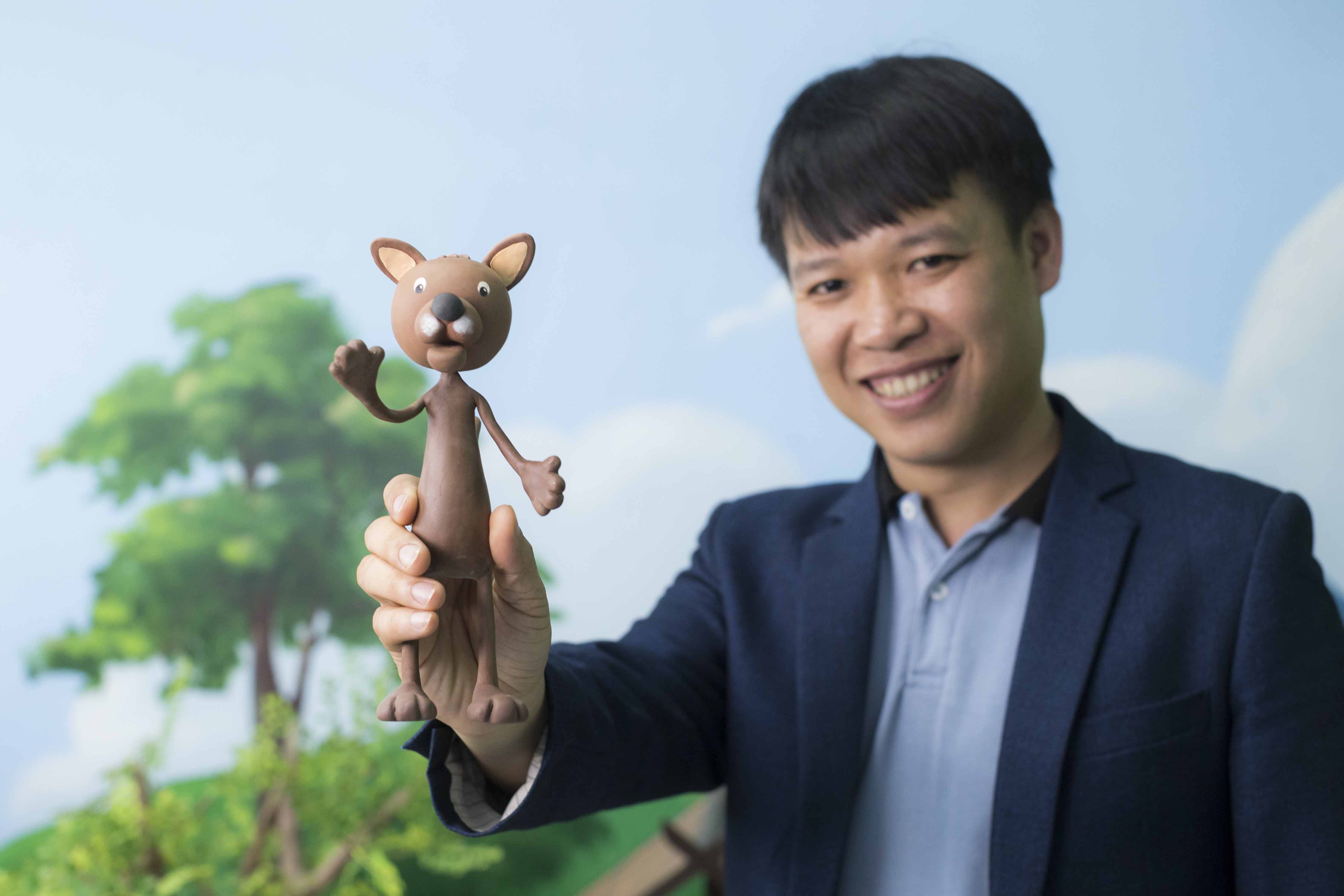ອີກໜຶ່ງສິລະປະກອນລາວທີ່ໄດ້ສ້າງຊື່ໃນເວທີສິລະປະກຳລະດັບໂລກ.
ຕອນແລງວັນເສົາ ທີ່ຫ້ອງວາງສະແດງຜົນງານສິລະປະ i:cat, ໄດ້ມີການວາງສະແດງລະຄອນສັ້ນ ທີ່ຫ້ອງວາງສະແດງຊັ້ນສອງ. ແຕ່ວ່ານັກສະແດງໃນເລື່ອງນີ້ບໍ່ແມ່ນຄົນແທ້ ແຕ່ເປັນນັກສະແດງດິນເບົາ ທີ່ຖືກປັ້ນ ແລະ ອຳນວຍການສ້າງໂດຍ ສຸລິຍາ ພູມິວົງ. ເມື່ອທ່ານແນມໄປທາງຈໍສາຍພາບ, ທ່ານຈະເຫັນຮູບປັ້ນຝູງຄວາຍຫລາກຫລາຍສີສັນຢືນເປັນໝູ່ ອ້ອມຮອບເປັນວົງມົນຢູ່ດ້ານຫລັງພື້ນສາກສີຂາວ. ເມື່ອຕົວລະຄອນມະນຸດກ້າວເຂົ້າມາໃນສາກ ຝູງຄວາຍໄດ້ຢຸດເຄື່ອນໄຫວ ແລະ ເບິ່ງມະນຸດເປັນຄືໂຕປະຫລາດ ເພາະຕົວລະຄອນມະນຸດ ແຕກຕ່າງຈາກພວກມັນ; ໃນມືຂອງຕົວລະຄອນມະນຸດ ຖືຫົວຄວາຍເອົາໄວ້, ລາວມີທ່າທີລັງເລໃຈວ່າລາວຈະສວມມັນດີບໍ່ ແລະ ສຸດທ້າຍ
ລາວກໍເລືອກທີ່ຈະສວມໃສ່ຫົວຄວາຍ ກາຍເປັນຄວາຍຄືກັບພວກມັນ ແລະ ຍ່າງຕາມກະແສນັ້ນໄປ.
ລະຄອນສັ້ນເລື່ອງນີ້ມີຊື່ວ່າກະແສຫລືເຊິ່ງໄດ້ຖືກນຳໄປສະແດງທີ່ເທດສະການງານສິລະປະAsian Pacific Triennial ໃນເດືອນພະຈິກປີກາຍນີ້ ທີ່ປະເທດ ອົດສະຕາລີ, ເຮັດໃຫ້ ສຸລິຍາ ກາຍເປັນໜຶ່ງໃນສາມສິລະປິນຄົນທຳອິດຂອງ ສປປ ລາວ ທີ່ໄດ້ສະແດງຜົນງານຂອງຕົນໃນງານວາງສະແດງທີ່ສຳຄັນລະດັບໂລກດັ່ງກ່າວ. ລະຄອນສັ້ນເລື່ອງ Flow ເປັນລະຄອນສັ້ນສະທ້ອນສັງຄົມທີ່ນຳເອົາຮູບແບບການປັ້ນແບບເດັກມາເປັນໂຕສື່ຄວາມໝາຍແລະ ສຸລິຍາ ມີປະສົບການທາງດ້ານການຜະລິດລະຄອນສຳລັບ
ເດັກນ້ອຍບ້ານຂອງຂ້ອຍທີ່ສາຍທາງໂທລະພາບມາເຖິງ 5 ປີ. ເຖິງແມ່ນວ່າ ໃນເບື້ອງຕົ້ນ ສຸລິຍາ ຈະປະຕິເສດທີ່ຈະເຮັດລາຍການກ່ຽວກັບເດັກນ້ອຍ ຍ້ອນວ່າລາວບໍ່ທັນແນ່ໃຈວ່າລາວຈະສາມາດສ້າງລາຍການສຳລັບເດັກນ້ອຍໄດ້ ຫລື ບໍ່, ແຕ່ສຸດທ້າຍ, ລາວກໍໄດ້ຄົ້ນພົບວ່າມັນເປັນວຽກທີ່ເຮັດໃຫ້ລາວມີຄວາມສຸກຫລາຍ.
“ເຖິງວ່າຈະພົບຄວາມຫຍຸ້ງຍາກໃນການປັບມຸມມອງໃນເບື້ອງຕົ້ນແຕ່ເມື່ອເຮັດໄປເລື້ອຍໆ, ຂ້າພະເຈົ້າ ກໍເລີ່ມເຫັນ ແລະ ເຂົ້າໃຈມຸມມອງດຽວກັນກັບເດັກນ້ອຍສຸລິຍາກ່າວ.ໃນໄລຍະດຽວກັນທີ່ໄດ້ສ້າງລະຄອນເລື່ອງ ບ້ານຂອງຂ້ອຍ, ສຸລິຍາ ກໍໃຊ້ເວລາໃນຍາມວ່າງທີ່ມີໃນການສ້າງຕົວລະຄອນທີ່ມີແນວຄິດເລິກເຊິ່ງຂຶ້ນ ຜ່ານສີສັນຕົວກາຕູນແບບຂອງເດັກນ້ອຍ.”
ຫລາຍທ່ານໃຫ້ຄຳເຫັນວ່າ ຍ້ອນວ່າສ່ວນໃຫຍ່ຂ້ອຍມັກຈະສ້າງເນື້ອເລື່ອງທີ່ມີລັກສະນະຈິງຈັງ ແລະ ມືດມົນ, ຂ້ອຍກໍຄວນສ້າງຕົວລະຄອນໃຫ້ອອກມາແບບມືດມົນຄືກັນສຸລິຍາກ່າວແຕ່ຂ້າພະເຈົ້າຄິດວ່າ ເນື້ອຫາຈະມີຄວາມໝາຍຍິ່ງຂຶ້ນ ຖ້າມັນ ເປັນສິ່ງທີ່ກົງກັນຂ້າມກັນກັບຄວາມໝາຍທີ່ມີ
ຄືດັ່ງໃນກໍລະນີລະຄອນສັ້ນເລື່ອງ Flow, ບຸກຄະລິກທີ່ລ່າເລີງສົດໃສຂອງຕົວລະຄອນກາຕູນດິນປັ້ນຂອງລາວ ໄດ້ເຮັດໃຫ້ເນື້ອຫາທີ່ເຄີຍມືດມົນ ເບິ່ງແລ້ວຄືສົດໃສຂຶ້ນ. ຄວາມຈິງແລ້ວລັກສະນະເນື້ອເລື່ອງ Flow ແມ່ນອອກແນວຈິງຈັງເຂັ້ມຂຸ້ນ, ຕົວລະຄອນຕ້ອງປະເຊີນໜ້າກັບຄວາມຕ້ອງການແລະ ຄວາມກົດດັນ ໃນການ ສວມບົດບາດ ເປັນອີກໜຶ່ງຕົວຕົນເພື່ອເຂົ້າກັບສັງຄົມໃຫ້ໄດ້ ເຖິງວ່ານັ້ນຈະບໍ່ແມ່ນຕົວຕົນທີ່ແທ້ຈິງກໍຕາມ.
“ຄົນຮັ່ງ, ທຸກ, ສະຫລາດ ຫລື ໂງ່ທຸກຄົນລ້ວນມີຂໍ້ບົກພ່ອງ ແລະ ຜັນໂຕໄປຕາມກະແສສັງຄົມເທົ່ານັ້ນ” ສຸລິຍາ ກ່າວ.

ເລື່ອງ Flow ສ່ວນໜຶ່ງແມ່ນໄດ້ແຮງບັນດານໃຈຈາກການສູ້ຊີວິດຂອງ ສຸລິຍາ ຕໍ່ກັບຄວາມກົດດັນໃນການພະຍາຍາມສ້າງສິລະປະນີ້ໃຫ້ເປັນອາຊີບທີ່ສ້າງລາຍໄດ້ຂຶ້ນໄດ້. ສຸລິຍາໄດ້ຮັບການຝຶກກ່ຽວກັບການແຕ້ມຮູບ ທີ່ສະຖາບັນວິຈິດສິນແຫ່ງຊາດ ນະຄອນຫລວງວຽງຈັນ, ເຊິ່ງລາວຮຽນຈົບຕັ້ງແຕ່ປີ 2008. ມາໃນປີ 2010, ລາວໄດ້ຮັບທຶນຈາກ Japan Foun-dation ແລະ ມີໂອກາດໄດ້ໄປຢູ່ ແລະ ສ້າງຜົນງານສິລະປະທີ່ບ່ອນວາງສະແດງສິລະປະ Youkobo Art Space ທີ່ເມືອງ ໂຕກຽວ; ແລະ ສະຖານທີ່ນີ້ເອງລາວໄດ້ສ້າງພາບເຄື່ອນໄຫວເລື່ອງທຳອິດຂອງລາວໃນຊື່ “ໂລກກ້ວາງໃຫຍ່ຂອງສົມຊາຍ” ແລະ ເຮັດໃຫ້ລາວ “ຕົກຫລຸມຮັກ” ໃນການເຮັດກາຕູນດິນປັ້ນ. ໃນປີດຽວກັນນັ້ນເອງ, ເມື່ອສຸລິຍາກັບມາຮອດນະຄອນຫລວງວຽງຈັນ, ລາວກໍໄດ້ເປີດສອນເທັກນິກການສ້າງຮູບເງົາສັ້ນ ແລະ ກາຕູນເຄື່ອນໄຫວ ໃຫ້ແກ່ ນັກສຶກສາຜູ້ທີ່ສົນໃຈໃນວິຊາດັ່ງກ່າວ ທີ່ສະຖາບັນວິຈິດສິນແຫ່ງຊາດ ແລະ ມາເຖິງປີ 2012 ລາວໄດ້ກໍ່ຕັ້ງ Clay House Studio ເຊິ່ງເປັນບ່ອນທີ່ຜະລິດວິດີໂອ ແລະ ພາບເຄື່ອນໄຫວ (Stop Motion) ເຊິ່ງຖືວ່າເປັນສະຖານທີ່ທຳອິດ ທີ່ຜະລິດຜົນງານແບບ Stop motion ຢູ່ລາວກໍວ່າໄດ້. ການທີ່ ສຸລິຍາ ຜັນໂຕອອກຈາກການແຕ້ມຮູບທຳອິດຄອບຄົວ ແລະ ໝູ່ເພື່ອນກໍບໍ່ຄ່ອຍເຫັນດີນຳປານໃດ. “ເມື່ອທ່ານເຮັດໃນສິ່ງທີ່ແຕກຕ່າງ, ຄົນອື່ນມັກບໍ່ເຂົ້າໃຈ” ສຸລິຍາກ່າວ. ຄົນອ້ອມຂ້າງລາວ ພາກັນເປັນຫ່ວງວ່າອາຊີບໃນການເຮັດກາຕູນດິນປັ້ນນີ້ ອາດຈະບໍ່ສາມາດສ້າງລາຍຮັບທີ່ໝັ້ນຄົງໃຫ້ລາວໄດ້. ສຸລິຍາ ຍັງຈື່ໄດ້ວ່າ ຕົນເອງຖືກຖາມວ່າ “ເປັນຫຍັງເຈົ້າຈິ່ງເຊົາແຕ້ມຮູບ? ເຈົ້າຈະຫາລາຍໄດ້ແນວໃດ?”
ໃນຂະນະທີ່ສິລະປະຂະແໜງອື່ນເຊັ່ນ ຮູບແຕ້ມ, ເຄື່ອງປັ້ນ-ດິນເຜົາ ແລະ ແຜ່ນແພຕ່າງໆ ເປັນທີ່ຍອມຮັບໃນລາວ ໂດຍສະເພາະໃນອຸດສະຫະກຳການທ່ອງທ່ຽວມາດົນແລ້ວ, ສ່ວນສິລະປະຮ່ວມສະໄໝ ສ່ວນໃຫຍ່ແມ່ນມີການສະໜັບສະໜູນທາງດ້ານການເງິນ ແລະ ທາງດ້ານວິຊາການຈາກຕ່າງປະເທດ. ເມືອງໃຫຍ່ໆເຊັ່ນສິງກະໂປ ແລະ ໂຕກຽວ ກໍພາກັນຮັບຮູ້ພອນສະຫວັນຂອງສິລະປະກຳຮ່ວມສະໄໝຂອງລາວ ຜ່ານງານວາງສະແດງ ແລະ ໂຄງການຕ່າງໆ. ແຕ່ວ່າສິລະປະກຳຮ່ວມສະໄໝ ຍັງບໍ່ທັນມີໂອກາດໄດ້ສະແດງຜົນງານຂອງຕົນພາຍໃນປະເທດເທົ່າທີ່ຄວນ.
ໃນປີທີ່ຜ່ານມາ, ຈາກຄວາມພະຍາຍາມຂອງນັກສິລະປະກຳລາວ ແລະ ເຈົ້າຂອງຫ້ອງວາງສະແດງຕ່າງໆ ໄດ້ສ້າງຄວາມເຂັ້ມແຂງໃຫ້ກັບວຽກງານສິລະປະກຳຮ່ວມສະໄໝຫລາຍຂຶ້ນ. ຫ້ອງວາງສະແດງ i:cat ກໍໄດ້ໃຫ້ການສະໜັບສະໜູນໃນການວາງສະແດງຜົນງານ. ສະຖາບັນວິຈິດສິນແຫ່ງຊາດລາວສົ່ງເສີມໃຫ້ນັກຮຽນນັກສຶກສາຫັນມາຮຽນສິລະປະກຳຮ່ວມສະໄໝ ຫລາຍຂຶ້ນກວ່າແຕ່ກ່ອນ. ຈໍານວນນັກຮຽນຂອງສຸລິຍາທີ່ມີພຽງແຕ່ 2 ຄົນໃນປີ 2014, ມາປີນີ້ແມ່ນມີເພີ່ມຂຶ້ນເປັນ 30 ຄົນ.

ສຸລິຍາ ເຫັນວ່າຄົນລາວມີການຕອບຮັບທີ່ດີ ຕໍ່ກັບຜົນງານທີ່ລາວສ້າງຂຶ້ນ ສະແດງໃຫ້ເຫັນວ່າຄົນລາວເລີ່ມຫັນມາສົນໃຈຮູບແບບສິລະປະກຳແບບໃໝ່ຫລາຍຂຶ້ນ “ໂດຍປົກກະຕິແລ້ວ, ຄົນທົ່ວໄປມັກຈະມາເບິ່ງງານສິລະປະ ສະເພາະແຕ່ມື້ເປີດງານວາງສະແດງ, ແຕ່ສຳລັບງານວາງສະແດງຄັ້ງນີ້, ມີຄົນເຂົ້າມາເບິ່ງທຸກມື້ແລະໃຊ້ເວລາຢູ່ທ່ຽວຊົມເບິ່ງຜົນງານຂອງຂ້າພະເຈົ້າເປັນຊົ່ວໂມງ” ສຸລິຍາກ່າວ. ສຸລິຍາເຫັນວ່າ ນີ້ບໍ່ແມ່ນພຽງແຕ່ເປັນຜົນສຳເລັດສ່ວນຕົວ, ແຕ່ມັນພິສູດໃຫ້ເຫັນວ່າ ນະຄອນຫລວງວຽງຈັນຂອງພວກເຮົາກ້າວໜ້າຂຶ້ນ ໃນວຽກງານສົ່ງເສີມສິລະປະກຳຮ່ວມສະໄໝ. “ຫລາຍປີກ່ອນ, ມີນັກສຶກສາມາຖາມຂ້າພະເຈົ້າວ່າ ເຮັດໄປລະຈະໄດ້ຫຍັງຄວາມໝາຍກໍຄືວ່າໄດ້ເງິນຈາກອັນໃດໃນການເຮັດວຽກນີ້. ຕອນນີ້, ຂ້າພະເຈົ້າກໍມີຄໍາຕອບໃຫ້ເຂົາເຈົ້າແລ້ວວ່າເບິ່ງຊີວິດອາຈານເປັນຕົວຢ່າງ.”
ແປ ແລະ ຮຽບຮຽງໂດຍ ວິໄລສອນ ເຫລື້ອງ
ຮູບໂດຍ ພູນຊັບ ເທວົງສາ / VAN HAI



 English
English
